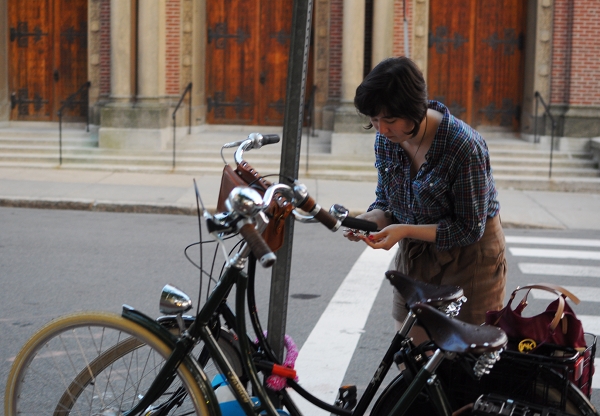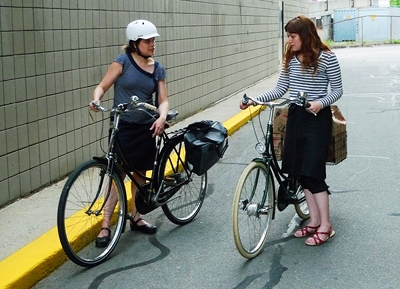A couple of weeks ago I wrote this post explaining why I do not believe that "Bike Month" is effective at making transportation cycling accessible to non-cyclists and beginners. In the discussion that followed, many different opinions were expressed - which I appreciate. In addition, a couple of readers suggested that, since I criticised the approach, perhaps I could follow up with my own ideas. If not bike month, then what alternative would I propose? That was a good point, and I have now prepared my response. This is far from the first time I've considered the issue. But it's one thing to have my head full of ideas, and quite another to express them lucidly. Let me give it a try.
A Support System for Cyclists
If the goal of a city, community, or organisation is to make cycling an accessible form of transportation, I propose a year-round support system permanently in place. This support system could exist in the form of a small department within the local government structure, or in the form of an independently funded non-government organisation. The sole mission of this department or organisation would be to provide a range of services - in the form of literature, materials, counseling, classes and workshops, and more - to persons interested in transportation cycling. It is crucial that the office or organisation providing these services be non-partisan - which includes independence from political groups, environmental organisations, or any other entities with specific agendas to pursue. The goal of this office or organisation would not be to promote cycling, but to support cyclists or those considering cycling - which is a crucial distinction. Trained employees would work with person, families, and groups to determine their level of comfort, their concerns and their goals - responding appropriately and providing them with relevant resources. The existence of this office or organisation would be made known to the public via an online presence, via brochures available at relevant local venus, and via announcements in the local media.
While I have quite detailed and concrete ideas of how this fictional entity would function, outlining all of them would require its own post - or more like a multi-page proposal. But I think you get the gist of what I envision. Having a solid, well-developed support system in the community that any cyclist can rely on is, would in my view, be more effective than a month-long annual event that is dense in activities while it lasts, only to end abruptly. A year-round support system would also send the message to the community that cycling is an accepted and attainable means of transportation.
A "How, Not Why" Approach
It is my belief that the chances of non-cyclists finding the idea of transportation cycling appealing are diminished, rather than improved by the "hard sell" tactics employed by the majority of bicycle activists (and by the very notion of bicycle activism, for that matter). When people try too hard to convince us that something is "good for us" or morally superior, our natural response is to be skeptical, to resist. After all - if it's so wonderful, then why are they trying so hard to persuade us and why isn't everyone already doing it? For this reason, I think it is misguided to "sell" cycling. Moreover, cycling doesn't need to be sold: It is a trend on the rise, particularly in large cities that are centers of popular culture. People everywhere are already enjoying riding their bicycle for transportation, and we need merely to communicate this fact as a given. Instead of telling people why they should cycle, make it an implicit assumption that they already want to do it (of course! doesn't everyone?) and focus on the how. I believe that this approach must underlie any initiative or outreach program designed to encourage new cyclists.
One thing discussed with particular zeal in the comments of my post about bike month, was the Bike to Work Week commuter booklet - a transportation cycling guide offered as promotional literature by the organisers of Bike Month. Here I described the ways in which nearly every page of the brochure portrays transportation cycling as a challenging and possibly dangerous athletic activity, which I believe makes the brochure intimidating rather than inviting. In response, I will outline my vision for an alternative brochure.
Title:
"A Guide to Cycling for Transportation"
Introduction:
Start by mentioning that cycling for transportation is becoming increasingly popular, and many people are wondering how to go about starting. This brochure is for them.
How to begin:
Explain how easy it is to commute by bicycle, dispelling myths that athleticism, energy bars, or special cycling clothing are necessary in order to commute to work on a bike.
Choosing a bicycle:
Inform of the existence of comfortable transportation bicycles, and explain which accessories are necessary in order to commute in work clothing. List bicycle shops that specialise in commuter bicycles and perhaps websites that focus on reviewing them.
Road rules:
Using clear and simple language, outline the basic cycling laws in your area, providing link to full version.
Safety:
Be objective and positive. Cite statistics that reveal bicycling to be a relatively safe activity. Stress the necessity of good brakes, proper lighting, and adherence to road rules first and foremost. Explain that opinions on helmets are mixed, and while some choose to wear them, others do not.
Illustrations:
Choose appealing images where persons are shown cycling at a relaxed pace while wearing street clothing and riding transportation bicycles with appropriate accessories. Include signs of normal, everyday activities: parents transporting children, persons in suits cycling with briefcases strapped to rear racks, grocery panniers with flowers sticking out, and so on. Images should communicate that cycling is easy, convenient and pleasant. Helmet use can be portrayed in a manner that represents freedom of choice: Some cyclists can be shown wearing one and other cyclists not, in a way that both come across as natural (see image above, or this image from a recent bike advert).
Further Resources:
Provide a list of popular websites focusing on transportation cycling.
Given that small, specific things are easier to implement than grandiose plans, I think that creating a brochure such as the one I outlined to counteract the one promoted via Bike Month would in itself be useful to those who are considering cycling for transportation and do not know where to begin. But making one - as well as thinking up the means of distributing it - is a project that would require hours of my time and is beyond the scope of this blog. Putting forth ideas is far more difficult than merely criticising, and I am exhausted from writing this post. Your thoughts on all of this are, of course, welcome.










0 comments:
Post a Comment